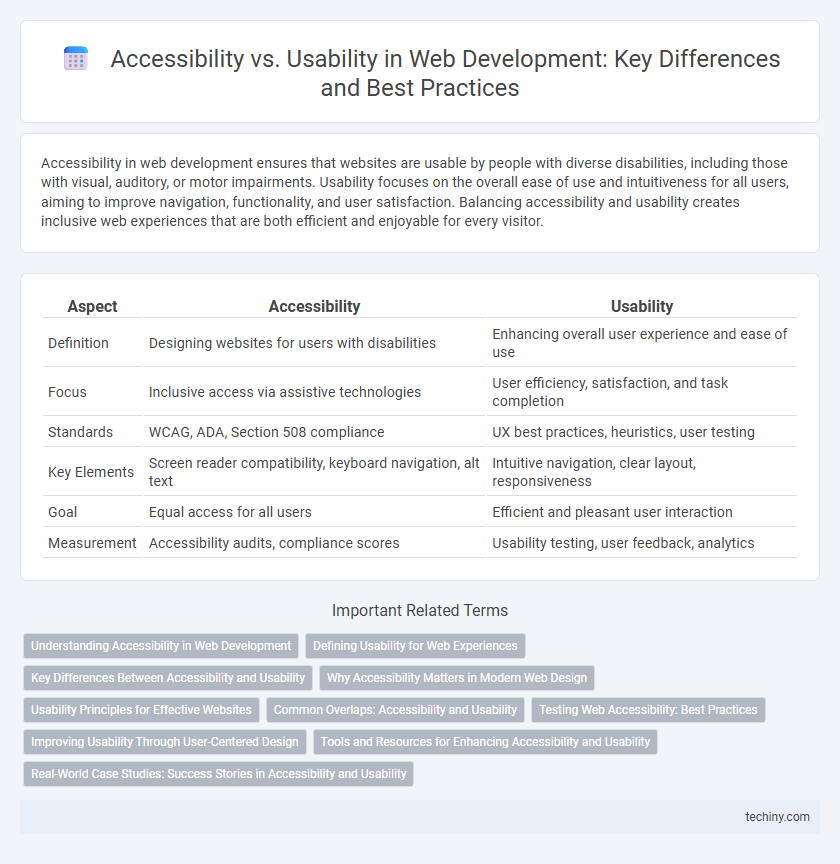Accessibility in web development ensures that websites are usable by people with diverse disabilities, including those with visual, auditory, or motor impairments. Usability focuses on the overall ease of use and intuitiveness for all users, aiming to improve navigation, functionality, and user satisfaction. Balancing accessibility and usability creates inclusive web experiences that are both efficient and enjoyable for every visitor.
Table of Comparison
| Aspect | Accessibility | Usability |
|---|---|---|
| Definition | Designing websites for users with disabilities | Enhancing overall user experience and ease of use |
| Focus | Inclusive access via assistive technologies | User efficiency, satisfaction, and task completion |
| Standards | WCAG, ADA, Section 508 compliance | UX best practices, heuristics, user testing |
| Key Elements | Screen reader compatibility, keyboard navigation, alt text | Intuitive navigation, clear layout, responsiveness |
| Goal | Equal access for all users | Efficient and pleasant user interaction |
| Measurement | Accessibility audits, compliance scores | Usability testing, user feedback, analytics |
Understanding Accessibility in Web Development
Understanding accessibility in web development involves designing websites that are usable by people with disabilities, including those with visual, auditory, motor, or cognitive impairments. Incorporating semantic HTML elements, ARIA roles, and keyboard navigability ensures inclusivity and compliance with WCAG guidelines. Prioritizing accessibility not only broadens the user base but also enhances overall usability and SEO performance.
Defining Usability for Web Experiences
Usability in web development refers to the ease with which users can navigate, understand, and interact with a website's interface, ensuring efficient task completion. Key elements include intuitive design, clear navigation paths, fast load times, and responsive layouts that cater to diverse devices. Optimizing usability enhances overall user satisfaction and retention by minimizing friction and cognitive load during web interactions.
Key Differences Between Accessibility and Usability
Accessibility ensures websites are designed to be navigable by users with diverse disabilities, following standards like WCAG to provide features such as screen reader support and keyboard navigation. Usability focuses on the overall user experience, aiming to make websites intuitive, efficient, and satisfying for all users by optimizing layout, navigation, and performance. Key differences include accessibility's emphasis on inclusivity and compliance with legal requirements, while usability prioritizes ease of use and effectiveness for the general user population.
Why Accessibility Matters in Modern Web Design
Accessibility in modern web design ensures that websites are usable by people with diverse abilities, including those with visual, auditory, or motor impairments. Prioritizing accessibility not only complies with legal standards like the ADA and WCAG but also broadens the audience reach and enhances overall user experience. Incorporating accessible features such as keyboard navigation, screen reader compatibility, and clear contrast boosts usability for all users, making web content more inclusive and effective.
Usability Principles for Effective Websites
Usability principles for effective websites emphasize intuitive navigation, clear content hierarchy, and responsive design to enhance user satisfaction and engagement. Ensuring fast load times, consistent layout, and accessible interactive elements helps accommodate diverse user needs and minimizes friction. Prioritizing usability not only improves user retention but also supports accessibility goals by creating seamless experiences for all visitors.
Common Overlaps: Accessibility and Usability
Accessibility and usability often overlap in web development by ensuring websites are both easy to navigate and inclusive for users with disabilities. Features like keyboard navigation, clear visual hierarchy, and consistent labeling improve overall user experience while meeting accessibility standards such as WCAG 2.1. Designing with these common elements enhances site functionality for everyone, including people with vision, hearing, or motor impairments.
Testing Web Accessibility: Best Practices
Testing web accessibility involves using tools like screen readers, keyboard navigation, and color contrast analyzers to ensure content is perceivable and operable by all users. Incorporating automated testing frameworks alongside manual assessments helps identify issues related to ARIA roles, semantic HTML, and focus management. Regularly validating against WCAG 2.1 guidelines ensures compliance and enhances both accessibility and usability for diverse user needs.
Improving Usability Through User-Centered Design
Improving usability through user-centered design involves creating web interfaces tailored to real user needs and behaviors, ensuring intuitive navigation and efficient task completion. Accessibility ensures that these designs accommodate users with disabilities by adhering to WCAG guidelines, which enhances overall user experience. Focusing on both accessibility and usability results in inclusive, easy-to-use websites that maximize engagement and satisfaction across diverse audiences.
Tools and Resources for Enhancing Accessibility and Usability
Web development benefits from specialized tools like WAVE and Axe that analyze and improve accessibility by identifying issues such as missing alt text and poor contrast. Usability testing platforms like UserTesting and Hotjar provide insights into user behavior, enabling developers to refine navigation and interface design. Combining these resources ensures websites are both accessible to users with disabilities and intuitive for all visitors, adhering to WCAG guidelines and enhancing overall user experience.
Real-World Case Studies: Success Stories in Accessibility and Usability
Real-world case studies highlight companies like Microsoft and Apple, who enhanced accessibility features such as screen readers and voice commands, resulting in improved usability for users with disabilities. Walmart's investment in accessible web design led to increased customer satisfaction and higher conversion rates, demonstrating the business value of inclusive usability. These success stories underscore the importance of integrating accessibility standards (WCAG 2.1) to create user-friendly experiences for diverse audiences.
accessibility vs usability Infographic

 techiny.com
techiny.com